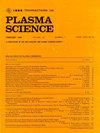Al/PTFE弹丸高速撞击薄铝靶产生的等离子体和闪光辐射特征
IF 1.3
4区 物理与天体物理
Q3 PHYSICS, FLUIDS & PLASMAS
引用次数: 0
摘要
为了揭示铝粉/聚四氟乙烯(Al/PTFE)弹丸超高速撞击2A12薄铝板时产生的等离子体和闪光辐射的特征参数及其演化规律,在传统Al/PTFE(铝粉与PTFE的质量比为26.5%/73.5%)工艺的基础上,对样品进行改进烧结工艺制备了Al/PTFE弹丸。采用自建分离式霍普金森压杆(SHPB)系统对试样的动态抗压强度进行表征。同时,利用两级轻气枪加载系统,结合高速摄像机采集系统、瞬态光纤高温计测量系统和等离子体特征参数诊断系统,对质量为0.22 g、尺寸为5 × 5 mm的增强Al/PTFE弹丸在不同冲击速度(1.95 ~ 2.45 km/s)下冲击厚度为2和3 mm的2A12铝靶进行了实验研究。实验研究了等离子体的电子温度、电子密度和闪光的辐射温度(在可见光波长范围内)。结果表明:在应变速率为4000 s−1时,快速冷却Al/PTFE试样的动态抗压强度较传统Al/PTFE弹丸(动态抗压强度为32 ~ 44 MPa)有显著提高,可达到100 MPa以上;超高速撞击产生的最高电子温度、电子密度和可见光辐射温度分别随着撞击速度和靶材厚度的增加而增加。本文章由计算机程序翻译,如有差异,请以英文原文为准。
Plasma and Light Flash Radiant Features Generated by Al/PTFE Projectile High-Velocity Impact Thin Aluminum Target
To reveal the characteristic parameters and the evolutionary rules of plasma and light flash radiation produced by aluminum powder/polytetrafluoroethylene (Al/PTFE) projectile hypervelocity impacting on 2A12 thin aluminum plate, the Al/PTFE projectile was obtained by the improved sintering process of the sample, which is based on the process of the traditional Al/PTFE (mass percentage ratio of aluminum powder and PTFE is 26.5%/73.5%). The dynamic compressive strength of the sample was characterized by the self-constructed split Hopkinson pressure bar (SHPB) system. Meanwhile, the experiments, enhanced Al/PTFE projectile (mass 0.22 g, size
$5\times5$
mm) impacting on 2A12 aluminum targets with the thicknesses of 2 and 3 mm at different impact speeds (1.95–2.45 km/s), have been performed using a two-stage light gas gun loading system combining with a high-speed camera acquisition system, a transient fiber pyrometer measurement system, and a plasma characteristic parameter diagnostic system. The electron temperature, electron density of plasma, and the radiant temperature (in the range of visible light wavelength) of light flash have been experimentally studied. The results show that the dynamic compressive strength of the Al/PTFE specimen with rapid cooling was significantly improved at the strain rate of 4000 s
−1
comparing with the traditional Al/PTFE projectile (the dynamic compressive strength was 32–44 MPa), which can reach more than 100 MPa. The maximum electron temperature, electron density, and visible light radiant temperature produced by the hypervelocity impact increase with an increase in impact velocities and target thicknesses, respectively.
求助全文
通过发布文献求助,成功后即可免费获取论文全文。
去求助
来源期刊

IEEE Transactions on Plasma Science
物理-物理:流体与等离子体
CiteScore
3.00
自引率
20.00%
发文量
538
审稿时长
3.8 months
期刊介绍:
The scope covers all aspects of the theory and application of plasma science. It includes the following areas: magnetohydrodynamics; thermionics and plasma diodes; basic plasma phenomena; gaseous electronics; microwave/plasma interaction; electron, ion, and plasma sources; space plasmas; intense electron and ion beams; laser-plasma interactions; plasma diagnostics; plasma chemistry and processing; solid-state plasmas; plasma heating; plasma for controlled fusion research; high energy density plasmas; industrial/commercial applications of plasma physics; plasma waves and instabilities; and high power microwave and submillimeter wave generation.
 求助内容:
求助内容: 应助结果提醒方式:
应助结果提醒方式:


